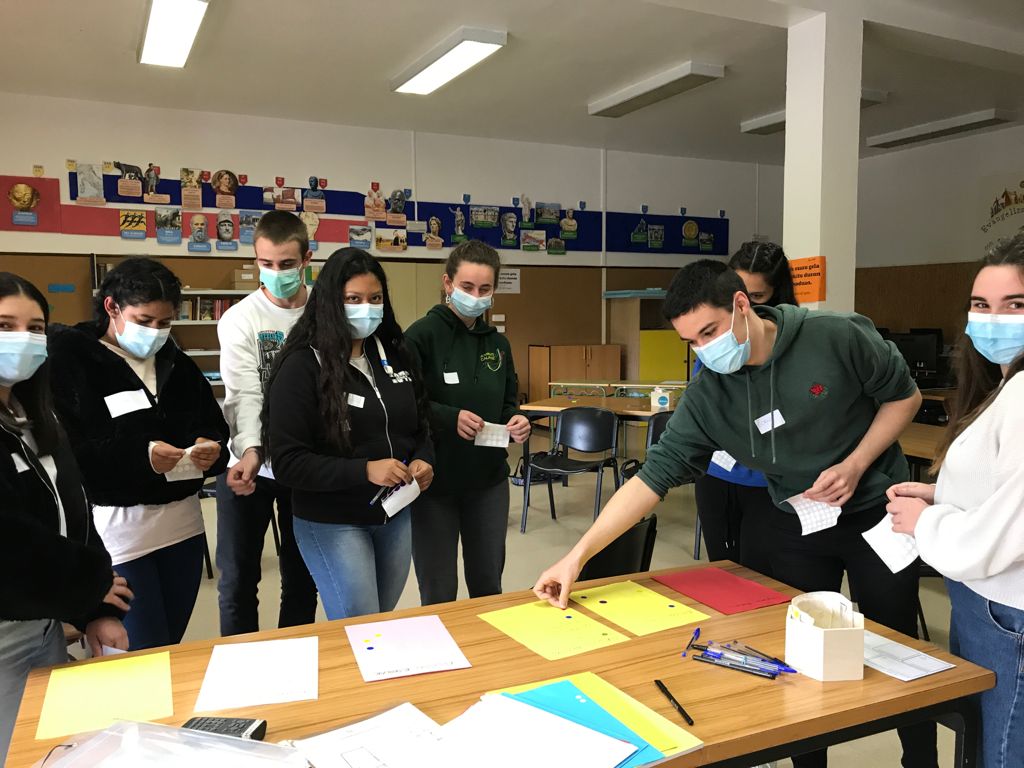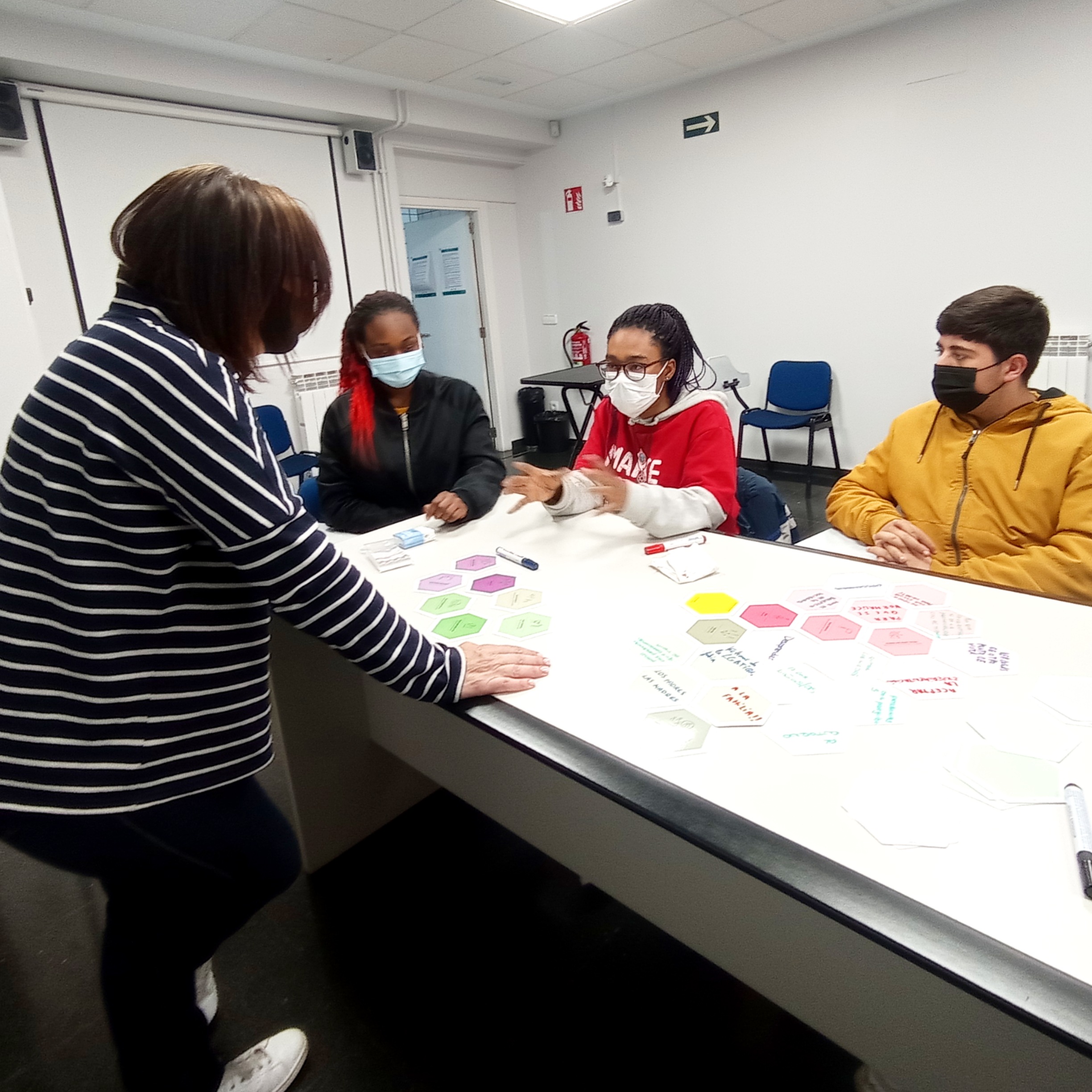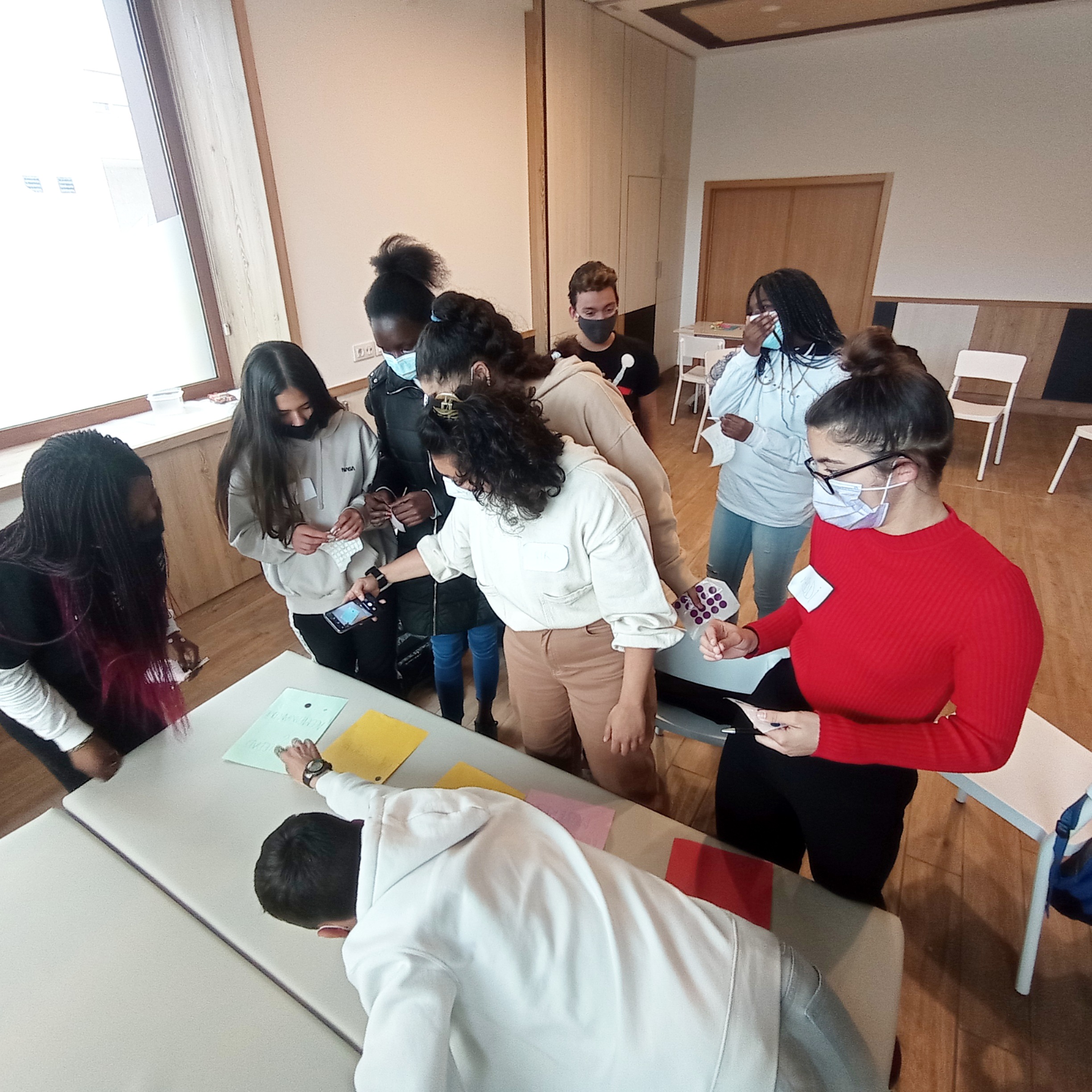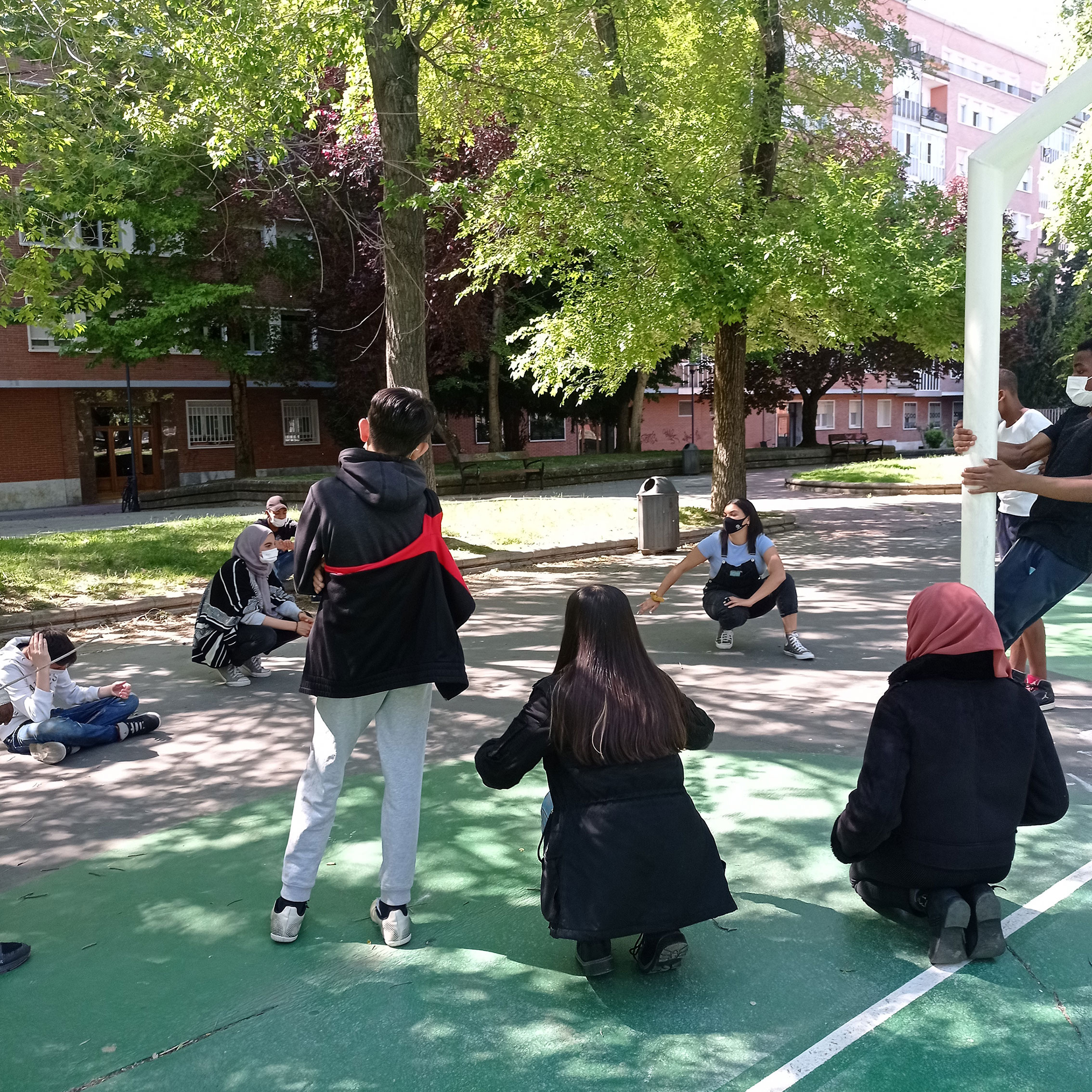Gazte Hiria is an urban interculturality and social innovation project in which more than 100 young people and teenagers at risk of exclusion from different districts of Vitoria-Gasteiz have participated. The aim has been to train them as driving forces and agents of social change, using methodologies of applied creativity with an artistic and cultural base. The young people defined 7 action areas. The project culminated in a stage play written and performed by them. https://bit.ly/3pDO1ei
Artehazia has developed "Gazte Hiria/Ciudad Joven", a social innovation project pointed at teenagers and young people, aiming to enable them to become drivers and agents of social change, to be able to influence and act in their environments in times of crisis. "Gazte Hiria" has worked with applied creativity methodologies from the cultural and artistic world, offered by Conexiones improbables (NEB's partner organisation), adapted for young people. The aim was to tackle diversity from diversity. Hence, people at risk of exclusion (themselves or their families) and others who are not, of different ages (100 young people between 13 to 25), from very diverse backgrounds, mainly from migrant-sending countries, but also from Spain, including Romany people, took part. They selected 7 action areas where they feel they can impact a stereotype and taboo riddled society: Diversity and Respect, Street Violence, Sexual Diversity, Youth Loneliness, Mental Health in youth, Child Mistreatment by very demanding parents, Stereotypes and Bullying. For each area they chose a challenge: the what, the why, the what for, the whom for and the how. To highlight these areas and their challenges, guided by an artist, they decided to create a stage piece titled "The Loop", which they wrote the script for, created the choreography, music and props for, performed and operated lights and sound in. The title comes from the fact that during the sessions with the youngsters they talked about living in a continuous loop. Things started and ended in the same way. Even if they changed the process, it was always the same. And they felt they were in a kind of loop.
The play was built around 4 characters: aggressor, victim, witness and society, common in the 7 action areas. The play was performed in Spanish, Basque and Arabic and, at some points, up to 9 of their mother tongues were used.
The project was developed between January and December 2021. The project can be seen at: https://bit.ly/3K9m3y
Please highlight how the project can be exemplary in this context
"Gazte Hiria/Ciudad Joven" is a socially sustainable project (it favours interculturality and inclusion), environmentally sustainable (from a coherent and balanced urban perspective as well as by respecting and caring for the habitat) economically (a viable, replicable project that favours the development of skills for the integration of young people) and culturally (since, in line with the United Nations UCLG Agenda 21 for Culture, we consider culture the driving force of this project, as the fourth pillar of sustainable development).
Vitoria-Gasteiz (Basque Country) is divided into 10 zones which we have worked with in "Gazte Hiria/Ciudad Joven". These offer all the basic facilities (education, health, sports, commerce and leisure) but, at the same time, there are few relationships between neighbourhoods, especially among young people and teenagers who narrow their relationships to their immediate urban environment. In addition, the arrival of migrants from different parts of the world (different cultures, religions, races, ethnicities, languages...) has created ghetto neighbourhoods where these people are gathered, given their lack of economic resources. This extends to the second generation who, at a family level, relate to people of their same origin and at a social level only ever meet with others at school, but without interacting with each other. For this reason, we have worked on their skill sets in order to achieve some of the Sustainable Development Goals, especially those that have more to do with inclusion. Fundamentally on SDG 10, Reducing Inequalities, because it can be leveraged to achieve SDG 8 (Decent Work and Economic Growth), which will be the one that will make it possible to achieve SDG 1 (End Poverty). In addition, we have also focused on SDG 3 (Health and Wellbeing), SDG 4 (Quality Education) and SDG 5 (Gender Equality).
Please highlight how the project can be exemplary in this context
In addition to the youth’s definition of the 7 action areas and their training in them, the use of artistic and cultural tools throughout the process has achieved objectives related to beauty and experience. We have helped these young people create a very special bond that has crossed the barriers that separated them until now. We wanted people who feel different to work together: Moroccans with Algerians, Spanish with Latinos, Germans with Portuguese, Sub-Saharans with Romany. In short, tackling difference from difference itself and making culture a means of social inclusion.
On the other hand, they have learned that creativity and the arts prove useful beyond just "having fun", that they are also working tools that achieve results. Thus, they have incorporated creative thinking into problem solving.
But we also wanted to get them to focus on making the results visible in an artistic way. And they did this through the production of a play in which they included all the action areas, the challenges defined in each one of them and the why, what for and whom for. The stage piece has been understood more as a vehicle for expressing the results of the project than as an object in itself. They have understood that without ethics there is no aesthetics.
There has also been a high emotional involvement with the project, which has progressively increased, and which has created a strong sense of empowerment through creative-based processes. The fact that the project has gone where they wanted it to go, with the mediation of Artehazia, but always trusting their criteria, has meant that the results have met their expectations and have generated new knowledge, as well as a different experience in their daily lives.
Please highlight how the project can be exemplary in this context
"Gazte Hiria/Ciudad Joven" is a unique project for its use of applied creativity methodologies of open and collaborative innovation with young people and teenagers; it has managed to instill in the youth’s worldview that arts and culture are useful tools to come up with solutions to different social challenges. It has managed to bring people together and create a city; to empower young people living in difficult situations to speak out, to change, through reflection, what they do not like about their environment. It has responded to different objectives:
- Citizen Participation. It has been a participatory project with young people and teenagers who were found thanks to a public call through very different yet accessible means and in different neighbourhoods of the city.
- Equal opportunities. The protagonists have been young people and teenagers coming from a variety of countries, from Europe, Latin America and Africa. We formed 7 working groups that have been made up of migrants and others of local origin; people at risk of social exclusion; young people living in shelters and juvenile centres, or those with a "normalised" family structure; people with resources and others who survive on social benefits.
- Co-design. In addition to the co-design with the young people themselves, we have had the support of IRSEAraba, Institute of Social Inclusion of Álava, and Conexiones improbables (NEB partner), specialists in co-creation with culturally based methodologies. To define the artistic piece, a creative person was brought in to work with the young people to help them shape the result.
- Public participation. "Gazte Hiria/Ciudad Joven" has won the Basque Government's Elkarlan prize in the inclusion section and the Social Innovation Prize of the Provincial Council of Álava. The project has been financed thanks to the Interculturality Grants of La Caixa Foundation and Artehazia's own contribution.
Please highlight how this approach can be exemplary
"Gazte Hiria/Ciudad Joven" is a "Covid19" project, motivated by what was experienced during the lockdown. In 2020, we saw how young people helped the elderly, the disabled, the lonely... or healthcare proffesionals by printing 3D material. These young people were essential for their families, as they acted as translators, carers, food and medicine providers, companions... But it was not a structured youth movement. And many of them were not prepared, neither professionally nor psychologically, for the tasks they took on. In Artehazia we believe it was necessary to empower them through a "different" training so that, in the case of a new social, economic, health or any other type of crisis, they would have a basic instruction and would be a driving force for social change, in order to achieve, fundamentally, SDG 10: reduction of inequalities. This is the one that can act as a lever to achieve other SDGs needed to build the Europe of the NEB. It was necessary to work with the young people themselves, from very different neighbourhoods of the city, central and peripheral, to fight against inequality in the urban environment and what it entails, as an essential part of sustainability; to detect what causes inequalities; to define in which areas they could be agents of change stemming from their own environments, the main challenges, the what, the what for, the whom for and the how. And they decided to make it visible through a play that was performed in up to 9 languages. Always working with open and collaborative innovation methodologies, with an artistic and cultural base.
“Gazte Hiria” has combined sustainability in its four dimensions, the enrichment, provided by the arts and culture, and inclusion, working with young people, empowering them, achieving results applicable to their futures but, above all, to their attitudes towards society and towards the rest of young people. Aimed at breaking down inequalities, achieving respect and inclusion based on difference.
"Gazte Hiria/Ciudad Joven" has had an impact on the young people and on other people who have participated in the project, on those who have promoted it, supported it, applied the methodology and carried out the mediation. The results with regard to the category "prioritising the places and people who need it most" are as follows:
- Broad participation and strong motivation for the fulfilment of the project, bearing in mind it has lasted one year and that it has been done with young people and teenagers.
- Attitudinal and organisational training to ensure that these young people are driving forces and agents of social change in their environment and can act in critical situations.
- Vision as a city, as a collaborative task between young people and teenagers from different neighbourhoods and social strata. Creation of synergies between people who until now had no relationship with each other and who now are interrelated, regardless of their age, social or cultural condition, religion, family background or sexual identity.
- Incorporation, within the worldview of young people and of the collaborating organisations, of the arts, of culture and creativity as useful tools to detect and solve social problems and challenges.
- Detection of priority action areas which concern young people.
- Completion of a project that can be replicated in other contexts.
- Accentuation and denormalisation of behaviours and attitudes that have been transmitted to young people and teenagers, also within the participants’ personal and social environments.
- Message to institutions that young people want to get involved in community decisions and that they will do so as long as the right vehicle is used.
- Demonstration that social innovation is not only innovation in social services but that it can be achieved in many other ways. At Artehazia, we are convinced that any project that is carried out, in order to be considered innovative, must have a social impact.
Please also explain the benefits that derived from their involvement.
- Artehazia's projects are based on different premises: they are hands-on, with citizens or social collectives; with open and collaborative culturally based innovation methodologies; where creativity is a transversal element throughout the project; seeking citizen empowerment; and where we work as facilitators and mediators of the process.
- “Gazte Hiria” had to be done with the participation of young people and teenagers; as an open project without preset results, since otherwise it would not be an authentic innovation project; with a process as enriching and important as its result; a method adapted to youth; wanting them to grasp culture and art as more than merely aesthetic things; that SDGs are not only set at the highest levels, people have an individual responsibility to make them possible.
- Supported by collaborating organisations (La Caixa Foundation, Conexiones improbables and IRSEAraba), we began a process in which we recruited participants and set up 7 working groups. We applied the methodology hoping they would make the decision, without direction, about which aspect to work on. They started from scratch, trusting Artehazia and unaware of where the project was headed or what its results would be, working with alternative methodologies in 2-hour sessions (each taking part in at least 8 working sessions). Based on the results of each session, Artehazia judged the tools to be applied next. Thus, although not deciding which resources to use, they did direct us to select, sometimes even design, tools to continue freely developing the project.
- When the participants decided to show the process through a play, they wrote the script, composed the music and performed it, created the choreography, defined the props and made them (clothes, stage...), controlled the lights and sound, translated the texts into different languages...
- Currently, some of the participants are applying the method used to make decisions or generate new ideas in their schools.
- Natasa Christou (Innovation Advisor to the Government of Cyprus), recently said that the 2030 Agenda is based on an urgent call to action to all countries to promote prosperity and protect the planet and that now, "there is a need to discover new models of operation and to reinvent our core life for a more conscious future". She therefore places particular emphasis on the need to integrate innovation in all sectors. And believes that culture can become a central component of sustainable development.
- In Artehazia, Association Cultural Innovation, Arts and Society, we have worked in these 3 perspectives: incorporating new models of doing (new methodologies of co-creation and co-design in citizen processes), integrating innovation in all sectors (an open and collaborative innovation, which places people at the centre and crosses different disciplines) and making culture a central component of sustainable development (our methodologies are artistic, cultural and creative based).
- We have worked focussing on reducing inequalities, which can be caused by global aspects, but also by local ones, and which affect, above all, the most disadvantaged people. That is why we have focused on SDG 10, Reducing Inequalities. And to do so, we wanted to provide training tools to people who might not otherwise have access to them. To reduce this inequality, we have come up with a participatory project with diverse people. We have worked on the basis of respect towards difference, integration and inclusion. We have managed to get people who, because of their origins or that of their families, would not interact in a natural way, to reflect and look for solutions together.
- At the same time, we have sought to respond to a deficit that has been repeatedly highlighted: the global challenge of encouraging youth participation in public affairs, common to all citizens.
- "Gazte Hiria/Ciudad Joven" is a hands-on, co-creation project that promotes and provokes social innovation, and through which excellent results have been achieved, including the process itself, which we consider a result in itself. But the real singularity of this project is the philosophy with which it has been carried out. Usually, citizen participation processes, which are more common with adults than with adolescents and young people, are based on challenges and interests that are often formulated by public administrations, especially local ones. And it is from there that citizen participation is requested. On many occasions as a way of validating an already defined solution.
- The uniqueness of this process, and others that we do from Artehazia, is that we are convinced that citizen participation has to walk a different path. That is why we start from the needs, interests and challenges defined by the citizens themselves, in this case young people, to develop processes in which they are the protagonists during the formulation of questions and the construction of answers. And from there, the involvement of other institutions and organisations is sought (see, then, how administrations can participate in citizens' affairs). It is a centrifugal participation, not a centripetal one, under the prism of social innovation (a sustainable innovation, centred on people and their environment, rooted, contextualised... that goes far beyond the issues traditionally considered social), making the arts and culture transversal vehicles for change towards sustainability, inclusion and happiness. Because without (applied) creativity there is no (social) innovation.
Please provide clear documentation, communication of methodology and principles in this context.
The results of the “Gazte Hiria/Ciudad Joven” project are transferable to other territories, players and other projects for different reasons:
- Because crises, bearing in mind "black swans", are increasingly more global (from the 2008 financial crisis, the still ongoing COVID-19 or the war in Ukraine) and young people are a social agent that must be taken into account.
- Because young people can be agents and driving forces of social change everywhere, both in Europe and outside the EU.
- Because preparation in other issues beyond the strictly curricular ones is a fundamental element for the good development of their lives and that of their families.
- Because migration is a phenomenon that has happened, is happening and will happen all over Europe (and elsewhere), caused by inequalities and also causing inequalities (both brought by forms of social and economic organisation). Therefore, working to achieve the fulfilment of SDG 10 is fundamental and fully translatable.
- Because working on social innovation from other perspectives and seeking other results is highly imperative.
- Because it is necessary to establish culture as a cross-cutting element in all the SDGs and the Green Deal.
- Because the incorporation of the arts, culture and creative thinking into innovation processes is not only necessary, but a key element in a new society of experience that develops under the prism of social innovation.
- Because if society has to change, and young people do not like what they have inherited (and this is the case in most parts of the world), we must make them the protagonists of change.
The methodology, processes, tools, milestones... are documented in different media, which facilitates not only the socialisation of the project but also its replicability in very different contexts. It is also a project with potential for growth within itself, as well as with teenagers and young people from other parts of Europe.
- The summary video of the entire project (including the play) can be seen on the website of our methodological collaborator Conexiones improbables: https://www.conexionesimprobables.es/v3/Gazte-Hiria--Conexionesimprobables--eng
- The applied creativity methodology used, with an artistic and cultural base, (https://www.conexionesimprobables.es/v3/How-we-work--eng ) has been expressly adapted to work with adolescents and put into practice with each of the groups in a 2-hour-workshop format. During these, methodological resources such as Improbable Encounters, Improbable Focus of Innovation (https://conexionesimprobables.es/v3/Workshop-Improbable-Innovation-focus--Conexiones-improbables--eng ), OpenLab (https://www.conexionesimprobables.es/v3/OpenLabs--Workshop-Conexiones-improbables--eng ) and Improbable Walks (https://www.conexionesimprobables.es/v3/Improbable-walks--Workshop-Conexiones-improbables--eng ) were used. In addition, we have also worked with the creative Álex Carrascosa who, after defining the challenges for each of the areas, helped create an artistic piece.




@Association Cultural Innovation, Arts and Society, Artehazia, 2021
Content licensed to the European Union.